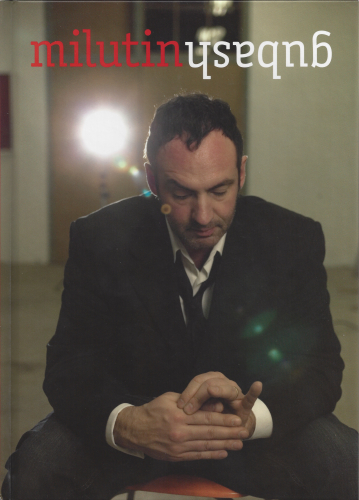Milutin Gubash, exhibition catalogue
Milutin Gubash, exhibition catalogue, co-published by Rodman Hall Art, Centre/Brock University, Carleton University, Art Gallery, Kitchener-Waterloo Art Gallery, Southern Alberta Art Gallery and Musée d’art de Joliette, 2013, 192 pages. Colour ill. Eng/Fra.
This beautiful, fully bilingual catalogue presents the work of multidisciplinary artist Milutin Gubash and is the collaborative effort of five Canadian and Quebec art galleries that exhibited many of the artist’s works from September 2011 to December 2012. Curators from the institutions, Sandra Dyck, Marie-Claude Landry, Shirley Madill and Crystal Mowry wrote the majority of the essays along with two invited authors, Sylvain Campeau and Mathilde Roman. Annie Gauthier, director of Musée d’art de Joliette, contributed the preface and an account by the artist’s mother Katarina Gubash (Urosevic) is included. Each of these essays explores an aspect of Gubash’s remarkable work, which mainly concerns fiction in order to tell the story of a lived experience in connection with what irremediably contributes to our personal identity.
In more than one essay, various authors mention the Serbian origins of the artist and his parents who migrated from Novi Sad to Canada, a significant aspect of the artist’s video work. Gubash, using the testimony of his parents, attempts to reconstruct the story of his family and his native country, the ex-Yugoslavia through this exodus. This experience, which opens up an intervening period between the here and there, the near and far, has without a doubt contributed to intensifying family ties. In sum, Gubash’s film work reminds us that we are beings who dialogue even if this dialogue at times is made up of silence, lies and inevitable disappearance. To shape this biographical material into an art form, Gubash counts on autofiction. This allows a creative distance, enabling him to invent in order to speak more easily about himself in private relationships with others. From this perspective, the use of a camera is essential. Through this mechanical eye, he develops a narrative using the television style of a sitcom. Situation comedy here serves as a strategy to present moments from his life in a humorous, even comical way. These staged events, reconstructing particular times in his life, are then rendered aesthetically significant. Even if “all fiction is an accident, a chance encounter,” this is what gives meaning to a story and direction to life.
These numerous texts, which at times inevitably return to the same themes that are part of the artist’s aesthetics, present a very relevant analysis of Milutin Gubash’s work, giving well-developed insight into the main points. This catalogue includes many video excerpts, photographs and installation views, and is an important document for anyone interested in learning about and understanding the work of this artist who—this being said without flattery—gives a good example of what it means to make of one’s life a work of art.
Translated by Janet Logan

Milutin Gubash, exhibition catalogue, co-published by Rodman Hall Art, Centre/Brock University, Carleton University, Art Gallery, Kitchener-Waterloo Art Gallery, Southern Alberta Art Gallery and Musée d’art de Joliette, 2013, 192 pages. Colour ill. Eng/Fra.





